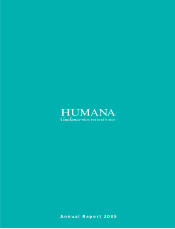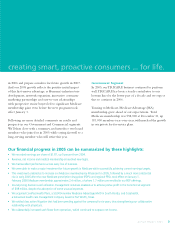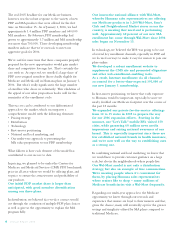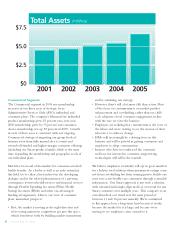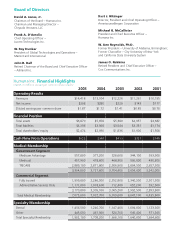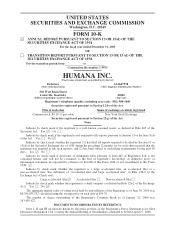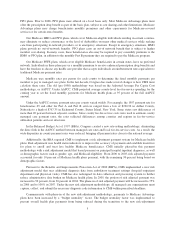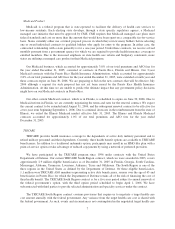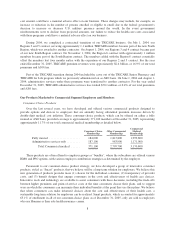Humana 2005 Annual Report Download - page 8
Download and view the complete annual report
Please find page 8 of the 2005 Humana annual report below. You can navigate through the pages in the report by either clicking on the pages listed below, or by using the keyword search tool below to find specific information within the annual report.
Commercial Segment
The Commercial segment in 2005 saw membership
increases in our three areas of strategic focus:
Administrative Services Only (ASO), individual and
consumer plans. The company’s HumanaOne individual
product membership grew 25 percent year-over-year,
ASO membership grew by 15 percent and consumer-
choice membership was up 52 percent in 2005. Growth
in each of these areas is consistent with our ongoing
Commercial strategy of migrating our group book of
business away from fully insured slice accounts and
toward self-funded and higher-margin consumer offerings
(including our Smart product family), while at the same
time expanding the membership and geographic reach of
our individual plans.
Much has been said of the market for consumer-oriented
health benefi ts. As a leader as well as an early entrant in
this fi eld, we’ve taken a keen interest in the developing
dialogue, and in the related phenomenon of a growing
convergence between health services and fi nancial services
through Flexible Spending Accounts (FSAs), Health
Savings Accounts (HSAs) and other tax-advantaged
funding arrangements. Here is our view of consumer
plans’ immediate prospects:
• First, the market is moving in the right direction and
we’re seeing numerous competitors get into this space,
which benefi ts us both by building market momentum
and by validating our strategy.
• However, there’s still a lot more talk than action. Most
of the focus on consumerism is on modest product
enhancement and cost shifting, rather than on a full-
scale adoption of real consumer engagement, in line
with the way we view the business.
• Employers are realizing that consumerism is the wave of
the future and we’re starting to see the erosion of their
reluctance to embrace change.
• HSAs will increasingly be a driving force in this
business and will be pivotal in getting consumers and
employers to adopt consumerism.
• Insurers who have not embraced the consumer
and have not invested in consumer-empowering
technologies will fall by the wayside.
We believe employers eventually will opt in great numbers
for a holistic total solution where permanent savings come
not from cost-shifting but from turning passive health-care
users into active health-care consumers through actionable
information. Our Smart approach is just such a solution,
with sustained mid-single-digit medical cost trend for our
Smart customers over multiple years. This compares to an
overall medical cost trend over the same period of
between 11 and 14 percent annually. We’re committed
to this approach on a long-term basis because it works,
because the market for it is large and because we’re
starting to see employers come around to it.
$2.5
$0
$5.0
$7.5 Total Assets (in Billions)
2001 2002 2003 2004 2005
6 Annual Report 2005

